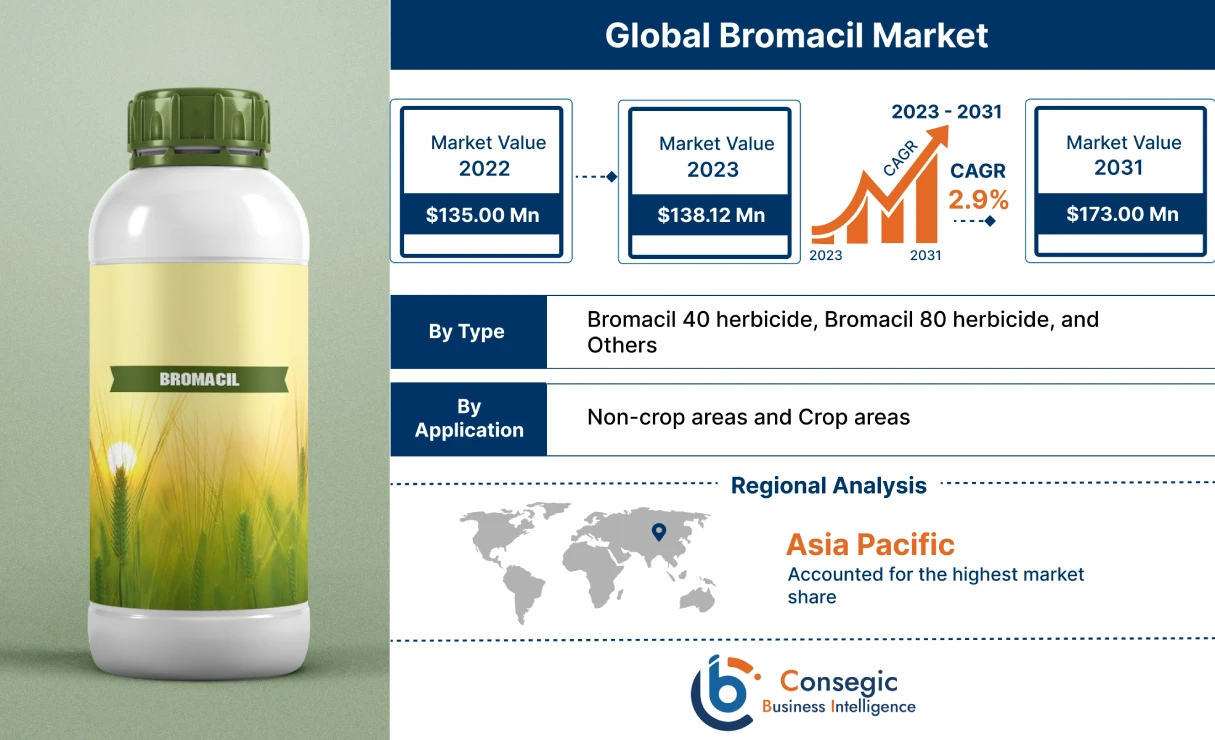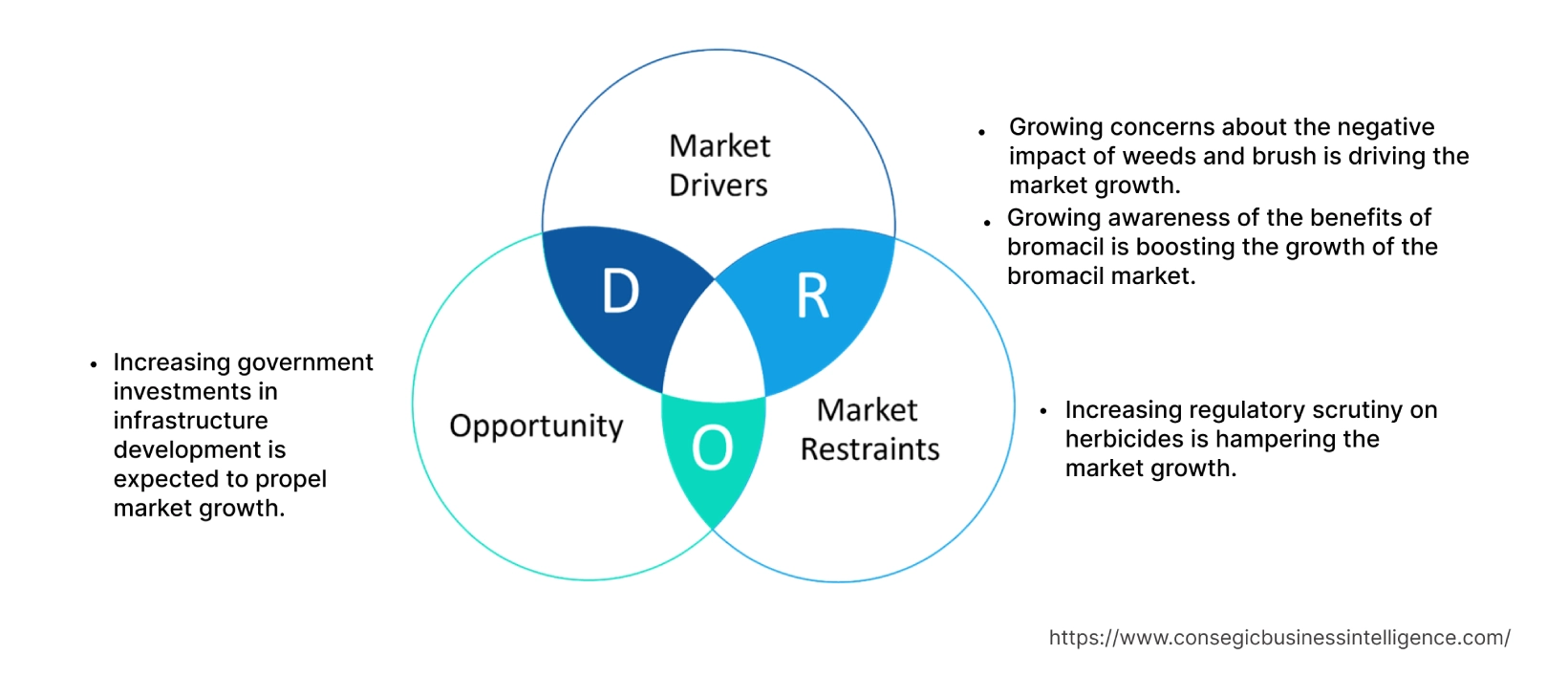Bromacil Market Introduction :
Consegic Business Intelligence analyzes that the bromacil market is growing with a CAGR of 2.9% during the forecast period (2023-2031), and the market is projected to be valued at USD 173.00 million by 2031 and USD 138.12 million in 2023 from USD 135.00 million in 2022.
Bromacil Market Definition & Overview:
Bromacil is an organic compound and a broad-spectrum herbicide that is used to control weeds and brush in nonagricultural areas, such as railroads, electrical switching stations, industrial yards, and others. It is also used for selective weed control on a limited number of crops, such as citrus fruit and pineapple.
Bromacil works by interfering with photosynthesis. It enters the plant through the root zone and moves throughout the plant, preventing it from producing the energy it needs to survive. Bromacil is a slow-acting herbicide, and it takes several weeks or even months to kill weeds and brush completely. Moreover, bromacil is a persistent herbicide, meaning that it can remain in the environment for long periods.
Bromacil Market Insights :
Bromacil Market Dynamics - (DRO) :
Key Drivers :
Growing concerns about the negative impact of weeds and brush is driving the market growth
Bromacil is an effective herbicide that can help to control weeds and brush in a variety of non-crop areas. Weeds and brushes have a huge negative impact on the environment and infrastructure. They reduce crop yields, damage roads and railways, and clog waterways. Thus, bromacil is widely demanded to control weeds and brush in non-crop areas, such as railroads, electrical switching stations, industrial yards, and others. Furthermore, bromacil is also used for selective weed control on a limited number of crops, such as citrus fruit and pineapple. Hence, due to the increasing concerns of the negative impact of weed and brush, the bromacil market is experiencing significant growth.
Growing awareness of the benefits of bromacil is boosting the growth of the bromacil market
Bromacil is a relatively safe and effective herbicide, and it offers several benefits over other herbicides. It can be used to control a wide range of difficult-to-control species which makes it a valuable tool for farmers and others. Furthermore, it can remain in the soil for several months or even years, providing residual weed control. Bromacil also helps to reduce the need for repeat herbicide applications. Also, it is less expensive than many other herbicides, making it a cost-effective option for farmers and other users. Overall, the growing awareness of the benefits of bromacil is a positive factor for the global bromacil market growth. Hence, due to the aforementioned factors, the bromacil market is witnessing positive growth.
Key Restraints :
Increasing regulatory scrutiny on herbicides is hampering the market growth
Governments around the world are increasing their scrutiny of herbicides, including bromacil. This is due to concerns about the potential negative impacts of herbicides on human health and the environment. The increasing regulatory scrutiny on herbicides is making it difficult to bring new bromacil products to market and could lead to restrictions on the use of bromacil in some areas. Bromacil can remain in the environment for long periods which can lead to concerns about the potential impact of bromacil on groundwater, drinking water supplies, and non-target wildlife. These environmental concerns are leading to restrictions on the use of bromacil in some areas. Hence, due to the aforementioned factors, the bromacil market growth is getting hampered.
Future Opportunities :
Increasing government investments in infrastructure development is expected to propel market growth
Bromacil is a broad-spectrum herbicide that is effective against a wide range of weeds and brush species. This makes it an ideal choice for controlling weeds and brush in infrastructure areas. Moreover, governments around the world are investing heavily in infrastructure development, such as the construction of new roads, railways, and power lines. For instance, according to a recent report by Invest India in 2023, the government of India has prioritized transport infrastructure in its overall spending. Alongside Railways, the Ministry of Transport and Highways allocation in the Budget 2023 increased by 36% over the previous year to develop new expressways. Hence, due to increasing government initiatives in infrastructure development and wide usage of bromacil in infrastructure areas, the bromacil market is expected to flourish significantly in the forecast period.
Bromacil Market Report Insights :
| Report Attributes | Report Details |
| Study Timeline | 2017-2031 |
| Market Size in 2031 | USD 173.00 Million |
| CAGR (2023-2031) | 2.9% |
| By Type | Bromacil 40 herbicide, Bromacil 80 herbicide, and Others |
| By Application | Non-crop areas and Crop areas |
| By Region | North America, Europe, Asia-Pacific, Latin America, and Middle East & Africa |
| Key Players | Adama Agricultural Solutions, Corteva Agriscience, FMC Corporation, Syngenta Group, Alligare LLC, AMVAC Chemical Corporation, Chem China Ltd., Nufarm Limited, UPL Limited, Wilbur-Ellis Company, DuPont, and Bayer CropScience |
Bromacil Market Segmental Analysis :
Based on the Type :
The type segment is categorized into bromacil 40 herbicide, bromacil 80 herbicide, and others. In 2022, the bromacil 40 herbicide segment accounted for the highest market share of 42.20% and is expected to grow at the fastest CAGR over the forecast period in the bromacil market. Owing to the increase in demand for low toxic and effective herbicides for weed control, the bromacil 40 herbicides are witnessing significant demand in the market. It is a broad-spectrum, residual herbicide that is effective against a wide range of weeds and brush. Bromacil 40 herbicide is also relatively inexpensive and easy to use. Furthermore, Bromacil 40 herbicide is available in a variety of formulations, including liquid solutions, granules, and tablets. This makes it easy to use bromacil 40 herbicide in a variety of applications. Hence, due to the aforementioned benefits of bromacil 40 herbicide, the segment is witnessing significant growth in the bromacil market.
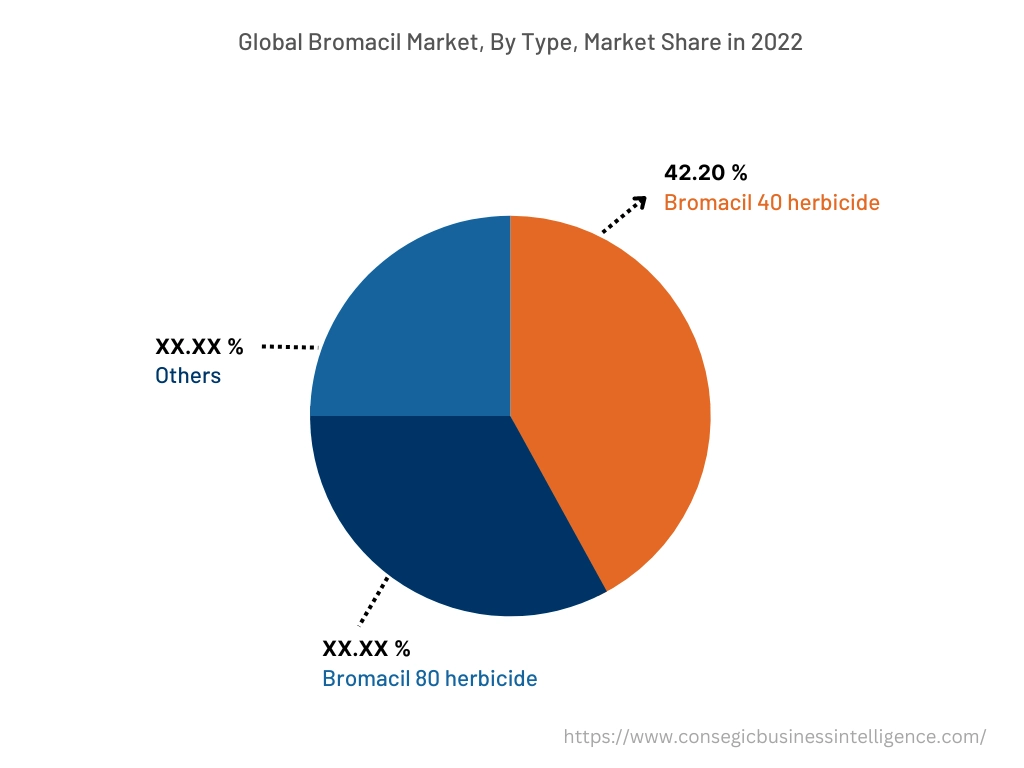
Based on the Application :
The application segment is categorized into non-crop areas and crop areas. In 2022, the non-crop areas segment accounted for the highest market share in the bromacil market. Bromacil is very effective against a wide range of weeds and brush species, including annuals, perennials, and woody plants. Bromacil is widely demanded in non-crop areas such as railroads, electrical switching stations, industrial yards, parks, forests, rangelands, and others. It is used to control weeds and brush along railroad tracks to prevent them from interfering with the safe operation of trains. Bromacil is also used to control weeds and brush around electrical switching stations to prevent them from interfering with the safe operation of electrical equipment. Furthermore, it is used to control weeds and brush in industrial yards to prevent them from interfering with operations and to create a more aesthetically pleasing environment. Hence, due to the wide usage of bromacil in non-crop areas, the segment is witnessing significant growth in the bromacil market.
Moreover, the crop areas segment is expected to grow at the fastest CAGR over the forecast period in the bromacil market. Bromacil is typically applied to crop areas as a pre-emergent herbicide, meaning that it is applied before weeds and brush emerge from the soil. Bromacil is used to control weeds and brush in citrus groves and pineapple fields. This helps to improve citrus and pineapple yields and reduce the cost of production. Thus, due to the aforementioned applications of bromacil in crop areas, the segment is experiencing positive growth in the bromacil market.
Based on the Region :
The regional segment includes North America, Europe, Asia Pacific, Middle East and Africa, and Latin America.
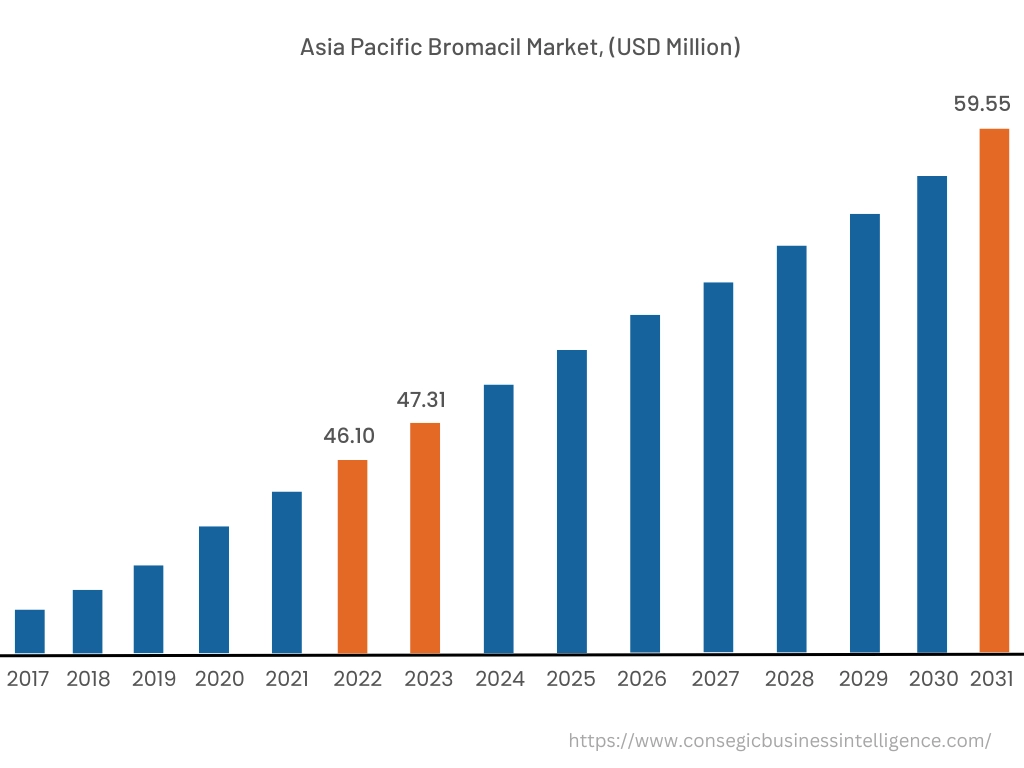
In 2022, Asia Pacific accounted for the highest market share at 34.15%, was valued at USD 46.10 million in 2022 and USD 47.31 million in 2023, it is expected to reach USD 59.55 million in 2031. In Asia Pacific, China accounted for the highest market share of 22.10% during the base year 2022. Different agrochemical companies are focusing on larger investments in the region as it has a high potential market for various crops, fruits, and vegetables. Furthermore, increasing farming practices in countries such as China and India and the rise in government initiatives to provide subsidies are acting as catalysts for the growth of the bromacil market in the Asia Pacific. Also, different government investments in infrastructure development are acting as growth drivers of the bromacil market in the region. For instance, according to a report by India Brand Equity Foundation in 2023, under the National Infrastructure Pipeline (NIP), projects worth USD 1.3 trillion are currently at different stages of implementation in India. Hence, due to increasing infrastructure projects and government investments in infrastructure development, the bromacil market is growing significantly in the region.
Moreover, North America is expected to witness significant growth over the forecast period, growing at a CAGR of 3.2% during 2023-2031 owing to increasing awareness about the benefits of bromacil in the region. Also, increasing demand for herbicides in non-crop areas in North America is driving the bromacil market growth in the region. Hence, due to the aforementioned factors, the bromacil market is growing significantly in North America.
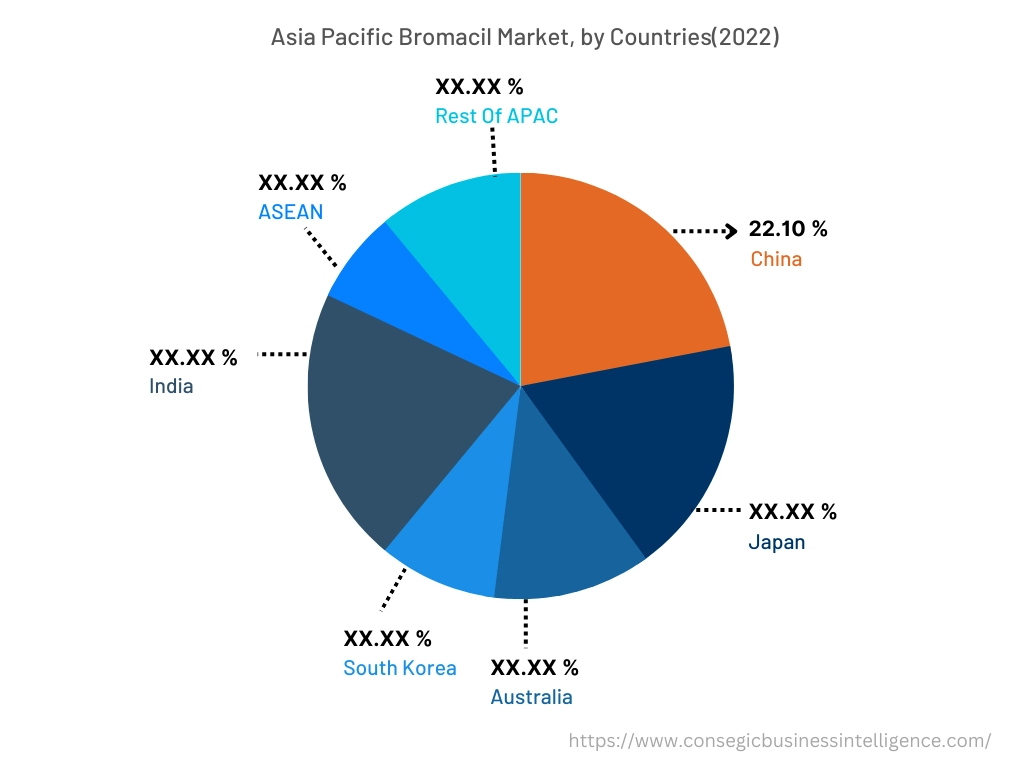
Top Key Players & Market Share Insights:
The bromacil market is highly competitive, with several large players and numerous small and medium-sized enterprises. These companies have strong research and development capabilities and a strong presence in the market through their extensive product portfolios and distribution networks. The market is characterized by intense competition, with companies focusing on expanding their product offerings and increasing their market share through mergers, acquisitions, and partnerships. The key players in the market include-
- T&CO.
- Harry Winston, Inc.
- HStern
- GRAFF
- RENAISSANCE GLOBAL LIMITED
- De Beers Forevermark
- Pandora
- CARTIER
- Le Petit-fils de L.U. Chopard & Cie S.A.
- Swarovski
- Pomellato S.p.A.
Recent Industry Developments :
- In August 2022, Pandora launched their new collection with lab-created diamonds and 100% recycled silver and gold.
- In December 2021, Harry Winston, Inc. announced the opening of their new retail salon in Milan, Italy.
Key Questions Answered in the Report
What was the market size of the bromacil industry in 2022? +
In 2022, the market size of bromacil was USD 135.00 million.
What will be the potential market valuation for the bromacil industry by 2031? +
In 2031, the market size of bromacil will be expected to reach USD 173.00 million.
What are the key factors driving the growth of the bromacil market? +
Growing concerns about the negative impact of weeds and brush is fueling market growth at the global level.
What is the dominating segment in the bromacil market by type? +
In 2022, the bromacil 40 herbicide segment accounted for the highest market share of 42.20% in the overall bromacil market.
Based on current market trends and future predictions, which geographical region is the dominating region in the Bromacil market? +
Asia Pacific accounted for the highest market share in the overall Bromacil market.
